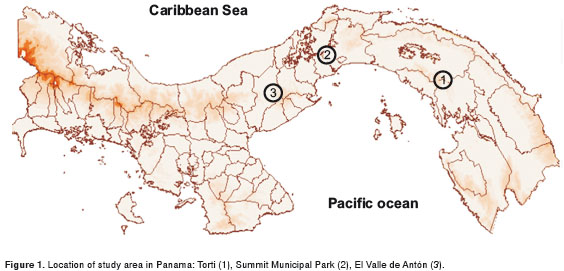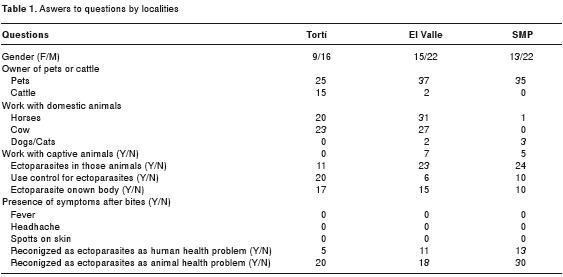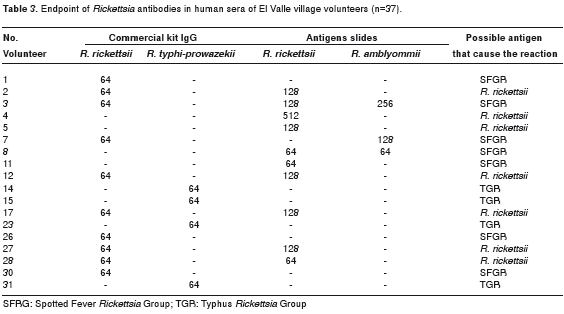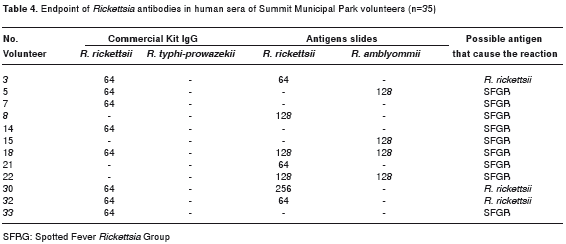Services on Demand
Journal
Article
Indicators
-
 Cited by SciELO
Cited by SciELO -
 Access statistics
Access statistics
Related links
-
 Cited by Google
Cited by Google -
 Similars in
SciELO
Similars in
SciELO -
 Similars in Google
Similars in Google
Share
Biomédica
Print version ISSN 0120-4157
Biomédica vol.33 supl.1 Bogotá Sept. 2013
https://doi.org/10.7705/biomedica.v33i0.831
doi: http://dx.doi.org/10.7705/biomedica.v33i0.831
ARTÍCULO ORIGINAL
Instituto Conmemorativo Gorgas de Estudios de la Salud, Panamá, Panamá
Author contributions:
Sergio E. Bermúdez: coordinated the activities of the project, analyzed the results and wrote the manuscript .
Cirilo Lyons: coordinated the laboratory activities.
Gleydis García: collaborated in the analysis and the results
Yamitzel Zaldívar: coordinated the blood draw in volunteers.
Amelia Gabster: collaborated in the interpretation of the data and the English translation.
Griselda Arteaga: collaborated in the interpretation of the data.
Recibido: 06/02/12; aceptado:02/09/12
Introduction: Since the middle of last century, cases of rickettsiosis have been found in Panamá when outbreaks of murine typhus and spotted fever were reported. Since then, little information exists about its prevalence in this country, since it is most often is misdiagnosed as another disease.
Objectives: The aim of this paper is to demonstrate the presence of Rickettsia infections in humans in three locations in Panamá. These locations are agricultural areas, near forested areas or those who work in zoo.
Materials and methods: Three locations where chosen for this study: Tortí, El Valle de Antón and workers in the Summit Municipal Park in Panamá City. All volunteers signed an informed consent and answered a questionnaire. The samples were analyzed for the detection of rickettsial spotted fever and typhus group by the indirect immunofluorescence (using commercial kits) and antigens of Rickettsia rickettsii and R. amblyommii.
Results: Blood samples were taken from 97 volunteers in Tortí (25), El Valle de Anton (37) and Summit Municipal Park (35). Of these, a total of 38 (39%) samples reacted to one of the two methods: eight (32%) in Tortí, 18 (48%) in El valle and 12 (34%) in Summit Municipal Park.
Conclusion: The results show a high prevalence of antibodies to Rickettsia belonging to the spotted fever group in each of the three study areas, in addition to presenting evidence of the typhus group Rickettsia in El Valle de Anton. These areas could be considered endemic for rickettsiosis as there are conditions for maintaining them.
Key words: Rickettsiaceae infections, immunoglobulin G, disease outbreaks, epidemiology, Panamá.
doi: http://dx.doi.org/10.7705/biomedica.v33i0.831
Evidencia serológica de infecciones de Rickettsia en humanos provenientes de tres localidades de Panamá
Introducción. Desde mediados del siglo pasado, se conocen en Panamá casos de rickettsiosis, cuando fueron reportados brotes de tifus en ratones y de fiebres manchadas. A partir de entonces, poca información se tiene sobre su prevalencia en este país, lo cual se debe principalmente a que son confundidos con otras enfermedades.
Objetivos. El objetivo de este trabajo fue demostrar la presencia de rickettsiosis en humanos provenientes de tres localidades de Panamá, que corresponden a zonas agropecuarias, cercanas a bosques, o que trabajaban en zoológicos.
Materiales y métodos. Se escogieron tres localidades para este estudio: Tortí (provincia de Panamá), El Valle de Antón (provincia de Coclé) y el Parque Municipal Summit en Ciudad de Panamá. Los voluntarios firmaron un consentimiento informado, además de responder un cuestionario. De cada voluntario se extrajo sangre venosa, la que fue analizada por medio de inmunoflorescencia indirecta, utilizando kits comerciales y láminas sensibilizadas con antígenos cultivados de Rickettsia rickettsii y Rickettsia amblyommii .
Resultados. Se tomaron muestras de 97 voluntarios, 25 en Tortí, 37 en El Valle de Antón y 35 en el Parque Municipal Summit. De estos, 38 (39 %) de las muestras fueron positivas en algunas de las dos técnicas practicadas: 8 (32 %) en Tortí, 18 (48 %) en El Valle y 12 (34 %) en el Parque Municipal Summit.
Conclusión. Se demuestra una alta prevalencia de anticuerpos contra Rickettsia del grupo de las fiebres manchadas en las tres áreas de estudio, además de presentarse evidencia de títulos para Rickettsia del grupo tifus en El Valle de Antón. Estas zonas podrían considerarse como endémicas por rickettsiosis, ya que existen condiciones que permiten el mantenimiento de las mismas.
Palabras clave: infecciones por Rickettsiaceae, inmunoglobulina G, brotes de enfermedades, epidemiología, Panamá.
doi: http://dx.doi.org/10.7705/biomedica.v33i0.831
Rickettsial diseases are a group of zoonosis caused by Gram negative bacteria of the genus Rickettsia . These diseases are among the oldest known vector-borne zoonosis infections, and even today are considered important emerging or re-emerging infectious diseases (1). These bacteria are transmitted by ectoparasites, which spread through the saliva of ticks (spotted fever group Rickettsia -SFGR) or by infected flea and lice excretions (typhus group Rickettsia -TGR) (2). Because the initial symptoms of rickettsial diseases are not specific, they are often confused with other common diseases like dengue, which results in underreporting and unreliable epidemiologic data (3).
The importance of rickettsial diseases has stimulated research on the different rickettsial species that could be considered pathogenic. For example, until the mid of 20th century, the only pathogenic Rickettsia that were considered were R. rickettsii (SFGR), R. prowazekii and R. typhi (TGR); nevertheless, now it is known that 16 of the 25 species are human pathogens (4). Of these, eight species might be involved in pathologies of humans in Latin America (5,6).
In Panamá, rickettsial diseases are known since the first half of the last century, when Calero (7) reported an outbreak of 13 cases of murine typhus in Panamá City. Subsequently, from 1950 to 1953, there were five cases of rickettsiosis by R. rickettsii in this country, including two mortal cases (8,9). As in other Latin countries, reports of rickettsiosis disappeared from Panamá for over 51 years, and it was not until the first decade of the 21st century, when there were new reports (10,11).
There is no solid epidemiological data of the extent of human rickettsiosis or of the different species that may be involved in human infections in Panamá. Therefore, the aim of this paper is to present preliminary results on the presence of rickettsial infectious in human serum from three locations in Panamá.
Materials and methods
Study sites
Three sites were chosen for our study, including volunteers from Torti area (provinces of Panamá and Darien), El Valle de Anton (Coclé Province) and workers of the Summit Municipal Park (Panamá Province) (SMP) (figure 1). These locations were chosen because previous reports have shown natural infection of Rickettsia within ectoparasites and mammals in these regions.

Torti is a rural community with an economy that is aimed primarily at farming, and it is surrounded by a secondary forest. There is no history of human rickettsial infections in this area. El Valle de Anton is located inside an extinct volcanic crater, at an altitude of 650 meters. This village is surrounded by Natural Reserve Cerro Gaital (1,200 m) and other natural sites that are often visited by locals and tourists. Inhabitants of this village are mainly engaged in agriculture and ecotourism (12). In 2008, a fatal case of spotted fever R. rickettsii occurred nearby (11), and as part of the investigation of this case, we obtained serum samples from family members of the deceased and volunteers working at the local zoo, El Níspero.
Summit Municipal Park (SMP) is 15 km from Panamá City and is surrounded by Soberania National Park. This park consists of a large garden and a zoo with animals representing Panamanian fauna (13,14). We obtained serum samples from garden workers, animal keepers, education personnel, administration and maintenance staff. Unlike the other people from our study, most of the workers of the SMP reside in urban areas (especially in Panamá City).
Inclusion criteria
As inclusion criteria, the volunteers had to be more than 18 years-old, to live or work at the study sites. Previously, all volunteers had signed an informed consent, according to the Bio-Ethical Committee standard. At the time of sampling, each volunteer answered a questionnaire about their work (including whether he or she manipulated live animals), the presence of pets at home, history of ectoparasites-bites, and the use of ectoparasites-control measures.
Serology
We extracted approximately 5 ml of venous blood, of which 20 µl of serum were used to determine IgG antibodies by indirect immunofluorescence method (IFA), using the Focus Diagnostics ® kit (Cypress, USA). For this analysis we followed the protocols recommended by manufacturers. The criteria for a positive result were a seroreaction in dilution of = 64. The slides were read using an ultraviolet microscope (Nikkon Eclipse E-400) at 1,000X magnification.
Additionally, we performed IFA using antigens cultivated from Brazilian strains of R. rickettsii (Taiacu) and R. amblyommii (AC37) from the collection of the Centre for Research in Tropical Diseases, Faculty of Microbiology at the University of Costa Rica. Each serum was diluted in PBS, starting from a 1:64 dilution. Then, ten microliters of diluted sera were added to each well of the antigen slides, and incubated at 37 °C for 30 minutes in a humid chamber. The slides were rinsed once, washed twice for 10 minutes per wash in PBS. The slides were incubated with fluorescein isothiocyanate-labeled goat anti-human IgG, followed the procedures previously described by Labruna, et al. (15). Sera reacting at the screening dilution (1:64) were then tested in serial two-fold dilutions to determinate the endpoint titer. To recognize the possible antigens that caused the reaction, we followed the approach proposed by Labruna, et al. (15).
Results
We included 97 volunteers in the study: 25 from Torti, 37 from El Valle de Anton, 35 workers from SMP. In total, 38 had positive seroreactions (39%) for one of the two tests performed (commercial antibodies and antigens cultivate). Titers of each locality are showed in table 2 - table 4. One-hundred percent of the volunteers confirmed having pets, and 41% used control agents against ectoparasites. Findings on awareness of the importance of ectoparasites in public health show that 100% of respondents recognized it as a problem in animal health, and 33% as a human problem. Other responses to questionnaire appear in table 1.

In the village of Torti we analyzed sera of 25 volunteers of which eight (32%) reacted to one of the two tests performed. There were no IgG antibodies responses against TGR (table 2). In the responses to the survey questionnaire, four volunteers said that they were continually exposed to ticks, all had animals at home, and only five applied anti-ectoparasites treatments.

At El Valle de Anton, sera of 37 volunteer were analyzed, of which 18 (48%) reacted to one of the two tests performed. Of these, nine (24%) had IgG antibody responses against SFGR antigens and four samples reacted against TGR (table 3). Importantly, among the nine positives for SFGR, five belonged to the family of the deceased in 2008.

We analyzed the sera of 35 volunteers at the SMP. Twelve (34%) appeared to be positive to one of the two tests performed (table 4). Among the volunteers with positive results, one worked at the greenhouse, three at the nursery, three at the zoo, two worked in ?? education and three in at the department of ground maintenance. Of these, eight said they had pets at home, all had seen ticks at their houses, and only seven used chemicals for tick control.

Discusion
Our results show a relatively high seroprevalence of human IgG antibodies against Rickettsia in the three study sites. It is important to mention, that the majority of the volunteers (44%) only reacted to endpoint, which could be attributed to past infections. For those samples where only reacted with one of the methods, may be due to cross reactivity with other agents; nevertheless, it is necessary to apply other methods to verify this. Further, the fact that the research was conducted in an area where ectoparasites have been reported infected with Rickettsia , reinforces the idea that these bacteria circulating in the environment, and could be into contact with humans through parasitism of infected ectoparasites . Similarly, this study analyzed serum of volunteers at risk of exposure to bites of ectoparasites (farmers and animal keepers at a zoo), which increases the possibility of being infected.
Other research in Latin America, have values of 4% seroreaction: in Jujuy, Argentina (16), 5% in Yucatán, México (17), 4.2% in an endemic area for spotted fever, São Paulo, Brazil (18), while Hidalgo, et al. , (19) show 40.3% seropositivity in an endemic area for SFGR in Cundinamarca, Colombia. Other studies in São Paulo have a positive rate between 14.3% (20) and 28% (21). Recently, Hidalgo, et al. , (22) found a high mortality rate (36%) associated with SFGR an outbreak from Córdoba, Colombia, and explained that the high fatality rate might be the result of treatment failures, as the exact agent of the infectious disease is often not known.
With regard to the high prevalence among Torti volunteers, it is possible that they carry out farming activities that put them at risk of being parasitized by infected ticks. There are previous records of R. amblyommii infection in the ticks Amblyomma cajennense s.l., Rhipicephalus sanguineus s.l., and Dermacentor nitens , in this area (23). This suggests that the ecological conditions that allow for human contact with infected ticks are present.
A similar explanation could apply to the inhabitants of El Valle de Anton, who not only maintain close contact with domestic animals infested with ectoparasites, but also frequent the wilderness areas surrounding the village. This would also explain the positive TGR with the commercial kit. Rickettsial species within the TGR are known to be present in Panamá since a murine typhus outbreak in the 30´s of the last century (7). However, there are no recent reports of R. typhi in humans, animals or fleas in Panamá, although this might be the result of a lack of directed studies. It has previously been demonstrated that R. amblyommii circulates in ticks from dogs and horses, while R. felis circulates in dog fleas and that sera from both horses and dogs were positive to rickettsial infection (12). This fact, combined with the high seroprevalence of R. rickettsii and the recent fatal case of rickettsiosis, indicates that SFGR might be endemic to this area. Further evidence for the TGR is needed.
With respect to volunteers working in the SMP, they not only showed exposure to ticks in the park, but also claimed to have pets at home. At least 17 species of ticks have recently been reported for this park, including species that can potentially parasitize humans (13,14).
Most importantly, the majority of the people who filled out questionnaires did not consider ticks and other ectoparasites as vectors of pathogens for human beings, and considered them only as transmitters of diseases in dogs, horses or cattle. Therefore, adequate dissemination of information could raise awareness among people about the consequences of not keeping their animals and living areas tick-free.
Similarly, health authorities should seek more recent information about detection techniques in suspected cases of rickettsiosis. This idea is reinforced by the knowledge that some techniques could yield false positive or nonspecific reactions, making it desirable to include other diagnostic methods (24). Recently, Spolindorio, et al. , (6) reported a case of rickettsiosis caused by a possible new agent, using serological and molecular tests, and demonstrated the importance of using multiple methods to detect these agents.
Finally, this study shows that rickettsial pathogens circulate among people who are in close contact with domestic and zoo animals and wildlife in Panamá.
We thank Laya Hun, Lizeth Taylor and Francisco Vega, from the Center for Research in Tropical Diseases, Faculty of Microbiology at the University of Costa Rica, to facilitate the plates seeded with antigens of R. rickettsii and R. amblyommii . To Nestor Sosa and Demetrio Serracin for their recommendations and improvement in the first version of the text.
This manuscript was written with the participation of all authors. We declare that there is no conflict of interest in the results presented in this article.
This project was supported with grant COL-07-045 by Secretaría Nacional de Ciencia y Tecnología (SENACYT) and ICGES.
Corresponding author: Sergio E. Bermúdez, Sección de Entomología Médica, Instituto Conmemorativo Gorgas de Estudios de la Salud. Panamá, Panamá. Tel: (507) 527 4811 bermudezsec@gmail.com
1. Parola P, Paddock C, Raoult D. Tick-borne rickettsioses around the world: Emerging diseases challenging olds concepts. Clin Microbiol Rev 2005;18:719-56. http://dx.doi.org/10.1128/CMR.18.4.719-756.2005 [ Links ]
2. Telford S, Parola P. Arthropods and Rickettsiae. In: Raoult D, Parola P, editors. Rickettsial diseases. London: Informa Healthcare; 2006. p. 27-35. [ Links ]
3. Danta-Torres P. Rocky mountain spotted fever. Lancet Infec Dis. 2007;7:724-32. http://dx.doi.org/10.1016/S1473-3099(07)70261-X [ Links ]
4. Fournier PE, Raoult D. Current knowledge on phylogeny and taxonomy of Rickettsia spp. Ann N Y Acad Sci. 2009;1166:1-11. http://dx.doi.org/10.1111/j.1749-6632.2009.04528.x [ Links ]
5. Labruna M. Ecology of Rickettsia on South America. Ann N Y Acad Sci. 2009;1166:156-66. http://dx.doi.org/10.1111/j.1749-6632.2009.04516.x [ Links ]
6. Spolindorio M, Labruna M, Mantovani E, Brandao P, Richtzenhain L, Yoshinari N. Novel spotted fever group Rickettsiosis, Brazil. Emerg Infect Dis. 2010;16:521-3. http://dx.doi.org/10.3201/eid1603.091338 [ Links ]
7. Calero C. Outbreak of typhus of the murine type; first report from the Isthmus of Panama. Am J Trop Med Hyg. 1948;28:313-21. [ Links ]
8. Rodaniche E, Rodaniche A. Spotted fever in Panamá. Isolation of the etiologic agent from a fatal case. Am J Trop Med Hyg. 1950;30:511-7. [ Links ]
9. Rodaniche E. Natural infection of the tick Amblyomma cajennense with Rickettsia rickettsii in Panamá. Am J Trop Med Hyg. 1953;2:696-9. [ Links ]
10. Estripeaut D, Aramburú M, Sáez-Llorens X, Thompson H, Dasch G, Paddock C, et al . Rocky mountain spotted fever, Panamá. 2007. Emerg Infect Dis. 2007;13:1763-5. doi: http://dx.doi.org/10.3201/eid1311.070931 [ Links ]
11. Tribaldos M, Zaldívar Y, Bermúdez SE, Samudio F, Mendoza Y, Martínez A, et al . Rocky Mountain spotted fever in Panamá: A cluster description. 2011. J Infect Dev Ctries. 2011;5:737-41. http://dx.doi.org/10.3855/jidc.2189 [ Links ]
12. Bermúdez SE, Zaldívar Y, Spolidorio M, Moraes-Filho J, Miranda R, Caballero C, et al . Rickettsial infection in domestic mammals and their ectoparasites in El Valle de Antón, Coclé, Panamá. Vet Parasitol. 2011;117:134-8. http://dx.doi.org/10.1016/j.vetpar.2010.11.020 [ Links ]
13. Bermúdez SE, Miranda R, Smith D. Ticks species (Ixodida) in the Summit Municipal Park and adjacent areas, Panama City, Panama. Exp Appl Acarol. 2010;52:439-48. http://dx.doi.org/10.1007/s10493-010-9374-8 [ Links ]
14. Bermúdez SE, Castro A, Esser H, Liefting, García G, Miranda RJ. Ticks (Ixodida) on humans from central Panama, Panama (2010-2011). Exp Appl Acarol. 2012;58: 81-8. http://dx.doi.org/10.1007/s10493-012-9564-7 [ Links ]
15. Labruna M, Horta M, Aguiar D, Cavalcante G, Pinter A, Gennari S, et al . Prevalence of Rickettsia infection in dogs from the urban and rural areas of Monte Negro Municipality, Western Amazon, Brazil. Vector Borne Zoonotic Dis. 2007;7:249-55. http://dx.doi.org/10.1089/vbz.2006.0621. [ Links ]
16. Ripoll C, Remondegui C, Ordóñez G, Arazamendi R, Fusaro H, Hyman M, et al . Evidence of rickettsial spotted fever and ehrlichial infections in a subtropical territory of Jujuy, Argentina. Am J Trop Med Hyg. 1999;61:350-4. [ Links ]
17. Zavala-Velazquez J, Ruiz-Sosa J, Vado-Solis I, Billings A, Walker D . Serologic study of the prevalence of rickettsiosis in Yucatan: Evidence for a prevalent spotted fever group rickettsiosis. Am J Trop Med Hyg. 1999;61:405-8. [ Links ]
18. Lemos E, Alavarenga F, Cintra M, Ramos M, Paddock C, Ferebee T, et al . Spotted fever in Brazil: A seroepidemiological study and description of clinical cases in an endemic area in the state of São Paulo. Am J Trop Med Hyg. 2001;65:329-34. [ Links ]
19. Hidalgo M, Sánchez R, Orejuela L, Hernández J, Walker D, Valbuena G. Prevalence of antibodies against spotted fever group rickettsiae in a rural area of Colombia. Am J Trop Med Hyg. 2007;77:378-80. [ Links ]
20. Horta M, Labruna M, Pinter A, Linardi P, Schumaker T. Rickettsia infection in five areas of the State of São Paulo, Brazil. Mem Inst Oswaldo Cruz. 2007;102:793-801. http://dx.doi.org/10.1590/S0074-02762007000700003 [ Links ]
21. Pinter A, Horta M, Pacheco J, Moraes-Filho J, Labruna M. Serosurvey of Rickettsia spp. in dogs and humans an endemic area for Brazilian spotted fever in the State of São Paulo, Brazil. Cad Saude Publica. 2008;24:247-52. http://dx.doi.org/10.1590/S0102-311X2008000200003 [ Links ]
22. Hidalgo M, Miranda J, Heredia D, Zambrano P, Vega, J, Lizarazo D, et al . Outbreak of Rocky Mountain spotted fever in Córdoba, Colombia. Mem Inst Oswaldo Cruz.2011;106:117-8. http://dx.doi.org/10.1590/S0074-02762011000100019 [ Links ]
23. Bermúdez S , Miranda R, Zaldívar Y, González P, Berguido G, Trejos D , et al . Detección de Rickettsia sp. en ectoparásitos de animales domésticos y silvestres de la Reserva Natural Privada Cerro Chucantí y comunidades aledañas, Panamá (2007-2010). Biomédica. 2012;32:189-95. http://dx.doi.org/10.7705/biomedica.v32i2.390 [ Links ]
24. Fenollar F, Fournier P, Raoult D. Diagnostic strategy of Rickettsioses and Ehrlichioses. In: Raoult D, Parola P, editors. Rickettsial diseases. London: Informa Healthcare; 2006. p. 315-30. [ Links ]













